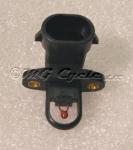-
Posts
1,613 -
Joined
-
Last visited
-
Days Won
2
Content Type
Profiles
Forums
Events
Gallery
Community Map
Everything posted by Dan M
-
This has been the heart of my theory from the beginning of this debate. I feel the plastic is used to slow response. To smooth out the extreme temp changes of an air cooled engine. Sorry if I'm being redundant here and I really don't want to start over from page 8 but think of it this way. You are riding a warmed up bike on a warm day. You come to a traffic light for a several minutes. Head temp increases greatly. There is no need to further lean the mixture. If anything, you want a rich mix to help keep the temp down. You take off and the head cools pretty quickly. No need to enrich. On a liquid cooled engine the temp will stay more constant once warmed up and the mixture will as well. A plastic holder and corresponding air gap removes the temp spikes from the equation, mimicking the temp signal seen on a liquid cooled engine.
-
I'd be surprised if it would stay running on throttle opening without a TPS signal.
-
I'm thinking the only limping is what you'll be doing after pushing it. On a non closed loop system it probably depends on what you loose. CTS? It will go rich or lean if it is open or shorted. ATS? Not much. TPS? I think it will stall on throttle opening. CKP/RPM? No start. Start unplugging stuff and see
-
I don't even know if the MM unit has a limp in mode.
-
Well boys & girls we've been through 23 pages of theories, opinions, facts and fiction. We've studied charts & graphs. Mused to paste or not to paste. Brass or plastic. Add heat-sinks? Have an air gap? What does it do? Does it do anything? Can the computer read it? Make it adjustable? Somewhere in all of this, maybe in one of the several PMs from various people I've received through the course of this, it was even indicated that those sensors were just switches used to turn on a cooling fan!?!? Here's a summary as I see it. The sensor has a definite effect on fuel mixture. Moto Guzzi uses coolant temp sensors on air cooled engines and calls them oil temp sensors, and sometimes uses air temp sensors to test oil temperature. Fuel injection for an air cooled engine is an adaptation of systems designed for liquid cooled engines. The brass holder allows more heat to get to the sensor than the plastic and is less likely to break under a ham fist. Adding paste to the holder allows more heat to get to the sensor's probe. If the bike came with a plastic holder it was likely mapped with a plastic holder. Adding heat to the sensor will lean the mixture. A leaner mixture will improve gas mileage. Too lean a mixture can create some running problems. We still don't know if the plastic was used for a reason. Sensors have various ranges of accuracy that nobody can agree on. There. That should get at least somebody grumbling.
-
Wow, I've never seen that type of sensor in anything but an air box. Where do they mount it? Here's a 30729331
-
I think your assumptions are probably good Raz. Certainly beyond me to make those calculations. I was looking at specs from various auto makers and most provide ohms but not the corresponding voltages. When reading data on a scan tool you generally see temp and voltage. Ford allows an ohm variance of 15% and Toyota shows a crude chart with a fairly wide range of acceptance as well. Still 15% is less than 10 degrees on your chart until you get to the cold (less accurate ) end of it.
-
Now you are losing me G2G. The oil temp sensor as guzzi calls it is a coolant temp sensor in any other application - brass sensor probe designed to be submerged in coolant. Part #29729461 The air temp sensor is exactly that. A plastic sensor body with an exposed thermistor probe designed to sense air temp. Part # 30729331 Two completely different sensors for two different purposes. I'm quite sure they are spec'd to be accurate in the ranges needed.
-
At least the sensor would be in liquid as it was designed. Another important discovery!
-
Right Dave, the ECU sends out a 5 volt reference to the sensor. The resistance of the sensor knocks down the voltage and that is what the computer sees. When it is cold the signal does not change steadily. You can hook up a meter to read either the ohms across the sensor or the voltage going back to the ecu (the better way) on the signal wire. What you will find is when the sensor is at low temps the temperature can change a few degrees and the ohms will not change then the ohms will change a great deal and stay there over the span of a few more degrees then make a big move again. (look at the stair steps in the graph linked in the earlier post) As the sensor gets into the range we've been speaking of, the ohms / volts are moving very steady (small even steps) with temp. I've never tested one at extremely high temps like 290F but I'd assume the opposite would be true, the changes (stair steps if you will) would be too small and difficult to measure, and the line in that graph would go almost horizontal.
-
It was good. I was pulling for the Aprilias but it was not to be. Those Suzukis were coming on strong, it should be an interesting season.
-
I agree wholeheartedly. I never said that 90-110 was at the end of the range. I said it was the accurate range. I'm sure the thermistor will continue to read at temps far higher than on the chart but there is simply no reason to publish temp / ohm numbers much above 130C or 140C because an engine is going to be toast by then. The engineers are not going to map fuel trims for an overheated engine. When a coolant temp sensor is shorted the scanned value is typically beyond 300F. Likewise when it is open it shows -40F - I'm guessing that is the approximate range of the spec'd thermistor. If you look at the chart that I linked to in a previous post. While it is rather crude you can see that when the graph makes a nice arc is is easy to get a steady voltage change. When things cool the line straightens out and ohms change in chunks. I'm sure if the graph went beyond operating temp (again, why would they?) the line would level out. However you want to term it, accurate, sensitive, least sensitive, The target range in this case with a typical coolant temp thermistor is 90C to 110C. Edit - I just have to add that if thermistors are can be made to function accurately in various temperature ranges, why would automotive (and motorcycle) engineers almost universally choose sensors calibrated to the same range and many times the exact same sensor if its sweet spot was not in the area of normal operating temperature? I mean really, to suggest that all these guys the world over would spec a sensor that was most accurate in the area where the engine didn't operate is quite absurd.
-
Does this mean that you can pack the holder with sugar and have the same effect as copper paste? Just when I thought I was out, they drag me back in.
-
I responded to your post by PM to save others some pain. This thread should be laid to rest.
-
No, it does not. First off, I'm not trying to "flame" you here. I understand your reasoning but you are looking at the entire range of the sensor. The map focuses chiefly on running temps with adjustments made outside of that range (colder) being less precise. The reason they use thermistors rather than a more linear resistance temperature detector is thermistors are more accurate over a small range. The range in this purpose is normal operating temperature. In modern internal combustion engines that range is 90 to 110C. The whole thing is emissions and fuel control. They need to be accurate to control fuel properly. In the early 1980s when electronic fuel injection was becoming more widespread some manufacturers did use a coolant switch that just closed at a certain predetermined temperature. It was quickly found that more accuracy was needed and the move to thermistors was made. When you monitor coolant temps with a scanner, you are looking at what the computer says it is seeing. During warm up temp reading is changing in chunks, sometimes 5 or more degrees at a time. Once the engine is up to operating temp you can watch the temp move degree by degree. In other threads on this subject, there were claims of better fuel economy after adding conductive paste to the sensor holder. This clearly demonstrates that fuel trim in the operating range is altered by sensing more heat. It is not simply an on / off switch. Vince Fischelli wrote an easy to understand article on the operation here: http://www.asashop.org/autoinc/may98/techtotech.htm Another article, here: http://www.facstaff.bucknell.edu/mastascu/...sors/TempR.html shows a graph that illustrates where the sensor has accuracy and how the accuracy fades off as temperature cools down. The fact that ohms increase in large, hard to determine chunks as temp cools, shows it is out of its calibrated range.
-
It is impressive to have two in the top ten. I love to see Aprilia thump Ducati on the nose early on.
-
Of course, it's winter. As least it is not 20 pages on drilling holes in rubber cush-drive pucks.
-
Sorry but you have it wrong. If you've ever measured one, the readings are steady and repeatable in the tight range and vary substantially when you get into the range out side of calibration. Edit: A sensor is more accurate if 10 degrees is represented by only 50 ohms rather than 500. Remember, the ECU is reading voltage after the sensor. Small ohm changes mean small voltage changes or accuracy. What you are suggesting is the engineers are having these sensors be in their most accurate range at -40C rather than in normal operating operating temperatures. Why?
-
Look at where the numbers tighten up: -40 100950 -30 53100 -20 29120 -10 16600 0 9750 10 5970 20 3750 25 3000 30 2420 40 1600 50 1080 60 750 70 525 80 380 90 275 100 205 110 155 125 100 In the range of 90C to 110C the variation is only 120 ohms. Pretty easy to pin point a temp. By comparison, 0C to 20C it is 6000ohms. Far greater margin for error. Make sense?
-
Just another quick thought here and I'll shut up. Looking at the spec'd sensor's values. It is ranged to be most sensitive in the 90C to 110C area. Interestingly, the exact operating temperature range of a modern liquid cooled motor. (thermostats typically open at 90 and cooling fans come on at about 110) The air cooled lump varies widely on either side of this range. Seems to lend some credit to someone's earlier theories on trying to mimic a coolant reading.
-
That is a bit of time spent there, thanks. Interesting stuff. It also adds to parking lot mystique triggering "what the hell is that" looks from bystanders. You can come up with a crafty tag for it "That's my fuel ratio dial" Your work proves what an archaic lump the V11 is. Seems it can't be made to run properly at anything near stoich. Fooling the ecu into thinking it is anywhere from 10C to 30C cooler than actual is likely providing substantially more fuel. It would be interesting to sniff it with a four gas analyzer, play with the resister and watch CO climb. I wonder if a fixed resister of say about 150 ohms would be a good compromise adding enough fuel to aid running without completely wiping out economy. Keeping the dial in place does aid in drivability and starting with the option of dialing down to regain some economy. A little too much fiddling for me though. Fuel injection is supposed to be accurate all by itself. Starts to make the carb option look attractive. For your next trick add some sort of ignition timing adjusting mechanism to the other bar, and a dial type fuel regulator (with gauge) You'll be akin to Igor making adjustments on the fly in the lab while readying for the big experiment. Hmm, maybe a discovery has been made.
-
Sorry, thought I posted earlier. Yes they are fitted. The combination of lighter wheels and a 170 rear tire has really quickened the steering. I'll post some pics soon.
-
First off, I'm not trying to pick a fight here. When somebody tells me I have something assbackwards I feel compelled to respond, explain or say thanks for the correction. Certainly a shorter sensor could have been spec'd to screw directly into the head. That part is easy, they come in all shapes and sizes. Cast iron would hold temp and slow things too much. No? You're sampling temp of an alloy head. Cast iron would really hold heat. I don't think they were trying to alter readings, just smooth them some. This has all been speculation and I suppose it is why we have a tech board. Input from DrJ if he was involved in this end of the design will be welcome. We all want to know why. The truth is out there...
-
The first word that came to mind was the obvious "bush" then as I moved on, "hedgerow" then I came upon the "thicket" Whew, you'd need to go at some of them with a rake in hand.
-
True but don't get scared. I'm with 'em on the bulb or connection at the rear. Switch is OK as the front comes on. Flasher is OK as the other side works.




